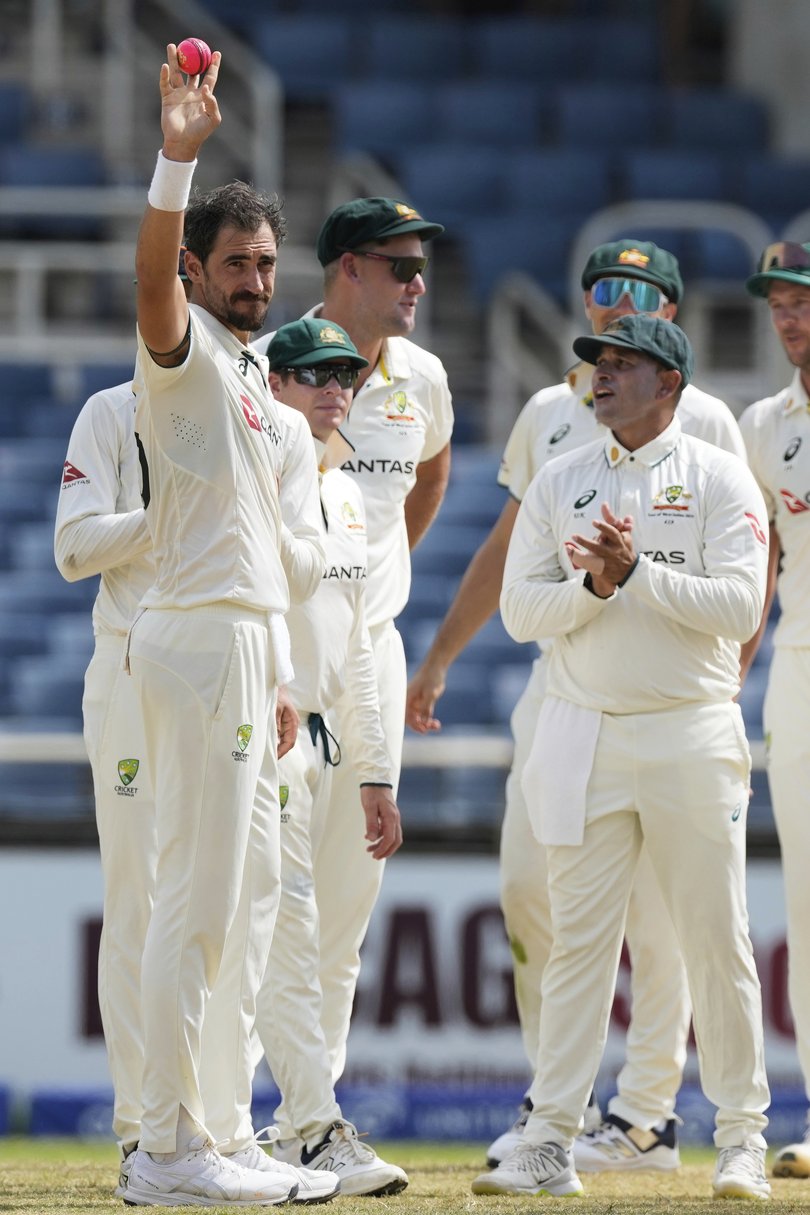MITCHELL JOHNSON: West Indies rout shows why day-night Test should be axed despite Starc’s brilliance
In a candid statement that caught my attention, Australia’s head coach Andrew McDonald remarked this week that the third Test in the West Indies – a day-nighter played with a pink Dukes ball - “didn’t even look like cricket.”
McDonald questioned the use of the pink Dukes balls going forward, saying: “That cricket was borderline impossible to play at certain stages”.
I’ll go a step further. Pink-ball cricket under lights has never looked like real Test cricket to me. And regardless of whether it’s a pink Dukes ball or a pink Kookaburra, Test cricket would be better off without it.
Sign up to The Nightly's newsletters.
Get the first look at the digital newspaper, curated daily stories and breaking headlines delivered to your inbox.
By continuing you agree to our Terms and Privacy Policy.The annual pink-ball Test match each Australian summer is not needed and should be scrapped.
Most of our Test matches are played during the school holiday period anyway and there is a huge diet of white-ball matches to fill the need for prime-time cricket – including the Big Bash on nearly every night.
Test cricket has remained so popular in Australia precisely because of the tradition, the battle between bat and ball that unfolds over five days and the contrast it provides with the shorter forms.
The pink ball, with its glow under lights, almost gives off a sense of artificiality.
As though it doesn’t belong in the pure setting of Test cricket. Pink-ball cricket is more like a modified one-day game or a longer version of a Twenty20 match.
Don’t get me wrong. I love seeing fast bowlers on the tear, having a purple patch doing fast bowler things. I will always appreciate quality fast bowling. Those moments when you rip through an opposition batting line-up, like when the Aussies skittled the West Indies for 27, feel amazing.
But the best feeling of all in Test cricket is being in a battle. It’s the back and forth, testing each other’s skills and mindset which creates the intensity which I think the players and fans ultimately want.
While the pink ball has gained widespread use in day-night Tests over the past decade, particularly in Australia and a few other nations following suit, McDonald’s comments call into question the authenticity of a format that has seen rapid changes in terms of style, conditions, and the way cricket is played.
Not to take anything away from Mitchell Starc as he has grown into one of the best left-armers in Australia’s history, but if you compare his red-ball stats to his pink-ball stats, you will see the difference.

So what is it about pink-ball cricket that deviates from the game as it was traditionally played? To understand this, we need to consider the unique characteristics of the pink ball, its impact on the format, and how it has changed the nature of the sport.
The pink ball, designed to enhance visibility under artificial light, was introduced to attract more people to come and watch Test cricket after work and offer a prime-time product for TV and has been a success in some respects, in particular at Adelaide Oval.
While the red ball retains its colour and properties based on its age for most of a Test match, the pink ball tends to change behaviour as the day progresses. It gets tougher to see the seam in the evening periods into night sessions, with conditions changed significantly in favour of the bowlers. This leads to a shift in playing conditions, with different aspects of the game being affected.
The pink ball has an extra layer of lacquer compared to red balls, to help maintain shine and visibility. So it tends to swing more, especially under lights. This behaviour is drastically different from the traditional red ball.
As McDonald pointed out, this variation leads to a situation where matches can become “more about the ball than the batsman,” changing the fundamental balance of the game. It becomes a battle of survival rather than skill.
Additionally, the surface for pink-ball matches usually has more grass left on it to protect the ball’s visibility, leading to less wear and tear and spin in the later stages of a match. This creates a scenario where spin bowlers may be left out for a four-pronged pace battery, like we saw with Nathan Lyon.
Traditionally, a Test match has a rhythm to it, built around the interplay between bat and ball across five days. However, the introduction of the pink ball has disrupted this natural flow and we tend to see shorter Test matches and even declarations based on the time of the day.
Test cricket, by its nature, is meant to be a battle of attrition, with both bat and ball needing to adjust to changing conditions across multiple days. When the pink ball drastically changes how the game is played within just one day, it feels less like the strategic, tactical sport that traditional Test cricket represents.
While the pink ball might have made Test cricket more accessible and viewer-friendly for some, it has altered the nature of the game in ways that don’t always feel aligned with the spirit of traditional cricket.
Whether the pink-ball game “looks like cricket” is subjective, but it’s undeniable that it has introduced new dynamics that change the way the game is played, watched, and experienced. I think cricket would be better off without it.
MITCHELL STARC’S TEST CAREER
Red Ball / Pink Ball / Total
- Tests: 86 / 14 / 100
- Wickets: 321 / 81 / 402
- Average: 29.52 / 17.08 / 27.02
